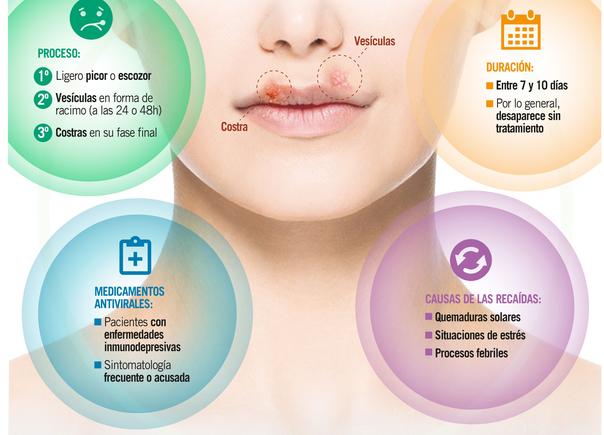15
03/2022
Herpes labialis or fever blister is an infection that affects, with or without symptoms, more than 80 percent of the world population. It is spread by contact and the cause is the herpes simplex virus (HSV-1) that usually affects the lips. Cold sores are distinguished by a cluster of small, fluid-filled blisters on or around the lips. When they break, a scab forms that heals in a maximum of four weeks and leaves no scar.
Causes of cold sores
Herpes simplex virus (HSV-1)
Cold sores are caused by herpes simplex virus type 1 (HSV-1) while herpes simplex type 2 (HSV-2) is usually responsible for genital herpes. Except that there is an exchange, for example, for the practice of oral sex; then there may be HSV-2 infection of the facial lips and HSV-1 infection of the genitalia.
The cause of contagion is direct contact such as kissing or sharing utensils such as crockery and cutlery or towels.
After an episode of cold sores, the virus remains inactive in the nerve cells of the skin and can reappear before:
- Viral infection.

- Fever.
- Hormonal changes.
- Stress.
- Fatigue.
- Exposure to sun or wind.
- Weak immune system.
- Treatments for HIV, severe burns, eczema, or chemotherapy for cancer treatment and medication to prevent organ transplant rejection.
How to Get Free Internet at Home Without Paying any Fee It is a truth universally acknowledged that an #internet co… https://t.co/YCgSSkJlhD
— Emma Lina Thu Oct 29 04:42:09 +0000 2020
Symptoms of cold sores
Stains and blisters with liquid
Cold sores usually appear on the area of skin where the lip meets the face and also on the nose or cheeks that take several days to four weeks to heal. After that time, we should consult a specialist, especially if cold sores appear frequently and, in addition, there is irritation in the eyes. In children, it can also appear on the fingers (herpes whitlow) when sucking the fingers.
The symptoms are: tingling and itching in the area where a reddened spot and fluid-filled blisters will appear in a few hours that can come together, suppurate and burst. The fluid is removed and a crust remains.
Some factors that influence the appearance of cold sores are:
- Fever.
- Erosion and sore gums.
- Throat pain.
- Headache.
- Muscle pains.
- Swollen lymph nodes.
- Children under 5 years of age can have cold sores inside the mouth that should not be confused with thrush.
Diagnosis of cold sores
Physical exam
Cold sores are diagnosed only with a physical exam.
Treatment and medication of cold sores
Creams to reduce symptoms
There is no specific cure for cold sores as they usually go away on their own in days or weeks, although your doctor may prescribe an antiviral drug to make them go away more quickly. The usual thing is to treat it topically with creams or ointments that numb the sores, dry the crusts or soften them.
Prevention of cold sores
avoid contact
It is always recommended to avoid direct contact, such as kissing, with infected people. You should also avoid sharing crockery, glassware, cutlery, napkins, cosmetics, sheets or towels with them. such as glasses, cosmetics or napkins.
In addition, other recommendations indicate that we should keep our lips hydrated so that the skin is in good condition and use a lip sunscreen in addition to resting well, avoiding stress and following a balanced and healthy diet to maintain optimal health.
oral diseases
What is leukoplakia? | Symptoms, causes and how to treat the disease What are cleft lip and palate? | Symptoms, causes and how to treat the disease

- 1443
- how to get lipstick out of napkins
Related Articles
The beauty secrets of these influencers over 50 will change your life
31/01/2022I'm certainly not what many would conventionally call "beautiful," but my attitude seems to make others think I am. My career on social media has been about challenging the norms...
50 Best Vanity Lighting in 2021: According to Experts
30/01/2022You can get any random vanity lighting, but if you're looking for expert advice to choose the best one for your needs, then you've come to the right place. No matter w...
Top 30 Colored Duct Tape Capable – Best Review on Duct Tape Colors
05/02/2022Home » Office Products » Top 30 Color Capable Duct Tape: Best Color Duct Tape ReviewOffice ProductsEsperanza Campoy2021 25 Views0 SaveSavedRemoved 0 ¿...
48 What is the best facial peel in 2021: according to the experts
02/05/2022You can get any random facial peel, but if you're looking for expert advice to choose the best one for your needs, then you've come to the right place.